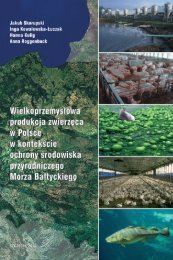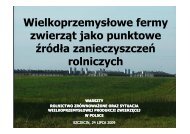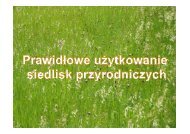best available technologies for manure treatment - Baltic Green Belt
best available technologies for manure treatment - Baltic Green Belt
best available technologies for manure treatment - Baltic Green Belt
You also want an ePaper? Increase the reach of your titles
YUMPU automatically turns print PDFs into web optimized ePapers that Google loves.
Best Available Technologies <strong>for</strong> <strong>manure</strong> <strong>treatment</strong> baltic sea 2020<br />
4: RESULT OF DATA ANALYSIS<br />
338 page long document, describing several aspects<br />
of pollution from pig and poultry farming. Energy<br />
issues and emissions to the atmosphere are in focus of<br />
the document. The lower focus on <strong>manure</strong> <strong>treatment</strong><br />
reflects the development in industrial pig farming<br />
since the document was adopted. At that time, the<br />
average Danish pig farm <strong>for</strong> example, had 550 pigs<br />
(including piglets, sows and production pigs) while<br />
the average herd size is 2.250 pigs today. The need<br />
to treat/process <strong>manure</strong> has vastly increased, and<br />
will most probably continue to increase as national<br />
economies in the new EU Member States increases.<br />
Livestock <strong>manure</strong> <strong>treatment</strong> <strong>technologies</strong> have<br />
impacts on the leaching of N and P, and they need<br />
to be considered within the BREF.<br />
Criteria <strong>for</strong> what is to be considered as a BAT<br />
<strong>for</strong> <strong>manure</strong> <strong>treatment</strong> in intensive rearing of poultry<br />
and pigs are not specified within the legislation or<br />
in the BREF.<br />
A review process of the current BREF <strong>for</strong> intensive<br />
rearing of poultry and pigs was initiated in June<br />
2008. The Technical Working Group members are<br />
asked to communicate recommended <strong>best</strong> <strong>available</strong><br />
techniques to the IPPC Bureau by February 2010.<br />
The official guiding documents <strong>for</strong> the revision process<br />
of the BREF on the IPPC webpage (http://eippcb.jrc.ec.europa.eu/index.html),<br />
do not so far give<br />
special attention to leaching of nutrients to water.<br />
Several respondents have shown interest in the<br />
“Best Practice Manure” project objectives and activities,<br />
especially the list of cost effective <strong>technologies</strong> to<br />
reduce leaching of nutrients from pig <strong>manure</strong>. There<br />
seems to be a window of opportunity to develop a<br />
BREF who gives better attention to leaching of nutrients<br />
to water, and promote cost efficient <strong>manure</strong><br />
<strong>treatment</strong> <strong>technologies</strong> that reduce this problem. It<br />
is important to take this opportunity, as it will take<br />
several years be<strong>for</strong>e the next review.<br />
36








